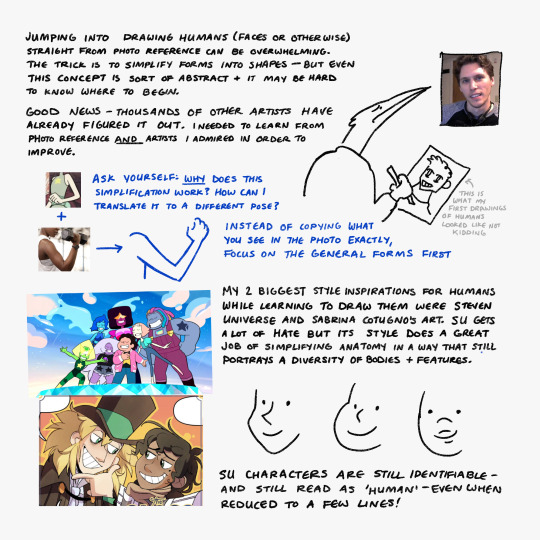#i realized this is pretty nonsensical while transcribing it LOL
Text



A set of very conceptual notes I drafted a while back for someone asking for advice on learning to draw humans. I'm entirely self-taught so this is less of a tutorial and more of a very rambling set of general principles I follow and ideas that helped while I was learning. I figured I'd post it in case anyone else could get use out of it!
I also recommend checking out:
Drawing East Asian Faces by Chuwenjie
How to Think When you Draw (lots of good tutorials in this series)
Pose reference sites such as Adorkastock
Transcript and some elaboration under the cut:
Img 1 - Drawing a face
The two most important elements (at least for me) when drawing a face are the outline of the cheek/jaw and the nose*. I often start with a circle to indicate the round part of the skull, then add a straight like and a 'V' to one side [to create the side of the face and the jaw].
The nose creates an easy template for the rest of the face's features to follow (eyebrows at the top of the nose bridge, eyes towards the center of the bridge, ear lines up to eye) and the placement/direction and overlap with other features is a very simple way to indicate dimension.
[A sketch of a face that has been adjusted by moving its parts to create 3 different angles. The following text is underneath:]
-Different 3/4th views can be created just by adjusting the position of and amount of overlap between the facial features.
- The top of the ear usually lines up with the corner of the eye. Think of how glasses are designed [specifically, how the arms run from the eyeline to the ear]
[I go on a tangent in these next few paragraphs]
*One thing I see many artists do - not just beginners - is learn how to draw A Person. As in, one singular person with one set of bodily proportions and one set of facial features. It's an issue that runs a bit deeper than 'same face syndrome' because sometimes these artists can draw more than one face, they're just not very representative of [the diversity present across] real people.
Part of the reason I'm talking more about how to think about approaches to drawing - rather than showing specific how-to's - is because there is no one correct or right way to draw a person. The sooner you allow yourself to explore variety - fat people, old people, people of color, people with [conventionally] 'unattractive' features - the easier it'll be! Artists often draw their own features honestly and without [harmful] caricature, so it's always a good idea to look at art made by the kinds of people you're trying to draw if you're ever unsure about how to handle something.
In general, it's far more important to learn how to interpret a variety of forms than to learn how to replicate the Platonic Ideal of the Human Body.
Img 2 - Stuff that helped me
Jumping into drawing humans (faces or otherwise) straight from photo reference can be overwhelming. The trick is to simplify forms into shapes - but even this concept is sort of abstract and it may be hard to know where to begin.
Good news - Thousands of other artists have already figured it out. [When starting out] I needed to learn from photo reference AND artists I admired in order to improve.
[When looking at stylization you are inspired by] ask yourself: WHY does this simplification work? How can I translate it into a different pose? Instead of copying what you see in a photo reference exactly, try to focus on the general forms first.
My two biggest style inspirations for humans while learning to draw them were Steven Universe and Sabrina Cotugno's art. SU gets a lot of hate [in this instance I was specifically referring to a time on tumblr when the art was knocked for 'losing quality'] but its style does a great job of simplifying anatomy in a way that still portrays a diversity of bodies + features.
[Extremely simplified drawings of Lapis, Steven, and Amethyst]
SU characters are still identifiable- and still read as 'human' - even when reduced to just a few lines!
Img 3 - Things I keep in mind while drawing side profiles
- Eyebrows + eyes close to the 'edge' of the face
- Forehead needs enough room for a brain
- Eye is > shaped from the sides
- Mouth kinda halfway [between the nose and the chin] but closer to the nose
- Skin/fat exists under the jaw [and connects to the neck]
- neck is about one half the width of the whole head
- the back of the skull always sticks out a bit further than you might expect
- Sometimes less is more - contours exist on every face, but drawing them in may make your character seem much older than they're supposed to be. However, it's a good idea to use them when you *want* your character to look old!
These are very general notes- every face is different and has different proportions [and playing around with them creates unique and interesting character designs]
#2023#may 2023#i realized this is pretty nonsensical while transcribing it LOL#feel free to send asks if anything is unclear#but again im not any sort of professional
562 notes
·
View notes